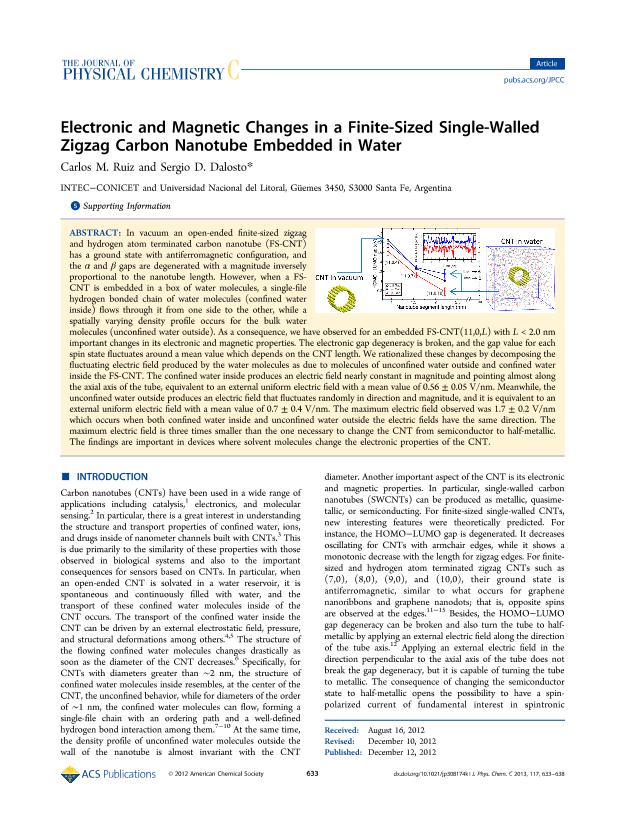Artículo
Electronic and Magnetic Changes in a Finite-Sized Single-Walled Zigzag Carbon Nanotube Embedded in Water
Fecha de publicación:
01/2013
Editorial:
American Chemical Society
Revista:
Journal of Physical Chemistry C
ISSN:
1932-7447
Idioma:
Inglés
Tipo de recurso:
Artículo publicado
Clasificación temática:
Resumen
In vacuum an open-ended finite-sized zigzag and hydrogen atom terminated carbon nanotube (FS-CNT) has a ground state with antiferromagnetic configuration, and the α and β gaps are degenerated with a magnitude inversely proportional to the nanotube length. However, when a FS-CNT is embedded in a box of water molecules, a single-file hydrogen bonded chain of water molecules (confined water inside) flows through it from one side to the other, while a spatially varying density profile occurs for the bulk water molecules (unconfined water outside). As a consequence, we have observed for an embedded FS-CNT(11,0,L) with L < 2.0 nm important changes in its electronic and magnetic properties. The electronic gap degeneracy is broken, and the gap value for each spin state fluctuates around a mean value which depends on the CNT length. We rationalized these changes by decomposing the fluctuating electric field produced by the water molecules as due to molecules of unconfined water outside and confined water inside the FS-CNT. The confined water inside produces an electric field nearly constant in magnitude and pointing almost along the axial axis of the tube, equivalent to an external uniform electric field with a mean value of 0.56 ± 0.05 V/nm. Meanwhile, the unconfined water outside produces an electric field that fluctuates randomly in direction and magnitude, and it is equivalent to an external uniform electric field with a mean value of 0.7 ± 0.4 V/nm. The maximum electric field observed was 1.7 ± 0.2 V/nm which occurs when both confined water inside and unconfined water outside the electric fields have the same direction. The maximum electric field is three times smaller than the one necessary to change the CNT from semiconductor to half-metallic. The findings are important in devices where solvent molecules change the electronic properties of the CNT.
Palabras clave:
Carbon Nanotubes
,
Antiferromagnetism
,
Qm/Mm
,
Nanoscience
Archivos asociados
Licencia
Identificadores
Colecciones
Articulos(INTEC)
Articulos de INST.DE DES.TECNOL.PARA LA IND.QUIMICA (I)
Articulos de INST.DE DES.TECNOL.PARA LA IND.QUIMICA (I)
Citación
Ruiz Tobon, Carlos Mario; Dalosto, Sergio Daniel; Electronic and Magnetic Changes in a Finite-Sized Single-Walled Zigzag Carbon Nanotube Embedded in Water; American Chemical Society; Journal of Physical Chemistry C; 117; 1; 1-2013; 633-638
Compartir
Altmétricas




